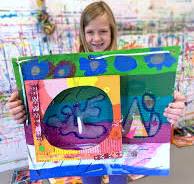Unleashing Creativity: The Transformative Power of an Art Project
The Power of Art Projects: Inspiring Creativity and Connection
Art projects have the remarkable ability to transcend boundaries, ignite imagination, and foster a sense of community. Whether it’s a large-scale public installation or a small personal creation, art projects have the power to inspire, challenge, and provoke thought.
Bringing People Together
One of the most beautiful aspects of art projects is their ability to bring people together. Collaborative art initiatives encourage teamwork, communication, and the sharing of ideas. Whether it’s a group mural painting or a community sculpture project, working together on a creative endeavour can create lasting bonds and connections.
Expressing Individuality
Art projects provide a platform for individuals to express their unique perspectives and experiences. Through painting, sculpture, photography, or any other medium, artists can convey emotions, tell stories, and explore their creativity in ways that words alone cannot capture. Art projects allow for personal expression and self-discovery.
Transforming Spaces
Public art projects have the power to transform ordinary spaces into vibrant hubs of creativity. Street art, outdoor sculptures, and interactive installations can turn dull urban environments into dynamic showcases of artistic expression. By engaging with their surroundings in new and unexpected ways, art projects can revitalise communities and spark conversations.
Inspiring Change
Art projects have the potential to inspire change by addressing social issues, raising awareness about important causes, and prompting dialogue on pressing topics. Artists often use their work as a platform to advocate for justice, equality, and environmental sustainability. Through thought-provoking installations and performances, art projects can challenge norms and inspire action.
Celebrating Diversity
Art projects celebrate diversity by showcasing different voices, perspectives, and cultural traditions. From multicultural exhibitions to collaborative cross-cultural initiatives, art has the power to bridge divides and foster understanding between people from all walks of life. By embracing diversity in all its forms, art projects enrich our collective human experience.
In conclusion, art projects play a vital role in inspiring creativity, fostering connection, and driving positive change in society. Whether big or small, personal or communal, every art project has the potential to make a meaningful impact on individuals and communities alike.
Understanding Art Projects: Common Questions and Insights
- What is an art project?
- How do you start an art project?
- What are some popular types of art projects?
- How can art projects benefit communities?
- What materials are commonly used in art projects?
- Are there any famous art projects that have made a significant impact?
- How can I get involved in collaborative art projects?
- What role do art projects play in education?
- Can art projects be used to raise awareness about social issues?
What is an art project?
An art project is a creative endeavour that involves the exploration and expression of ideas, emotions, and concepts through various artistic mediums such as painting, sculpture, photography, or performance. It is a structured process that allows individuals or groups to engage with their creativity, experiment with different techniques, and communicate messages or narratives through visual or sensory means. Art projects can range from personal expressions of individual identity to collaborative efforts that aim to provoke thought, inspire change, or celebrate diversity. Ultimately, an art project is a vehicle for artistic exploration and self-expression that can take many forms and serve multiple purposes within the realm of creativity and culture.
How do you start an art project?
Embarking on an art project can be an exciting yet daunting endeavour for many aspiring creatives. To start an art project, it is essential to begin with a clear vision or concept that ignites your passion and creativity. Consider what message or emotion you want to convey through your art and how you intend to express it. Researching different techniques, mediums, and styles can also provide valuable inspiration and guidance. Setting specific goals, creating a timeline, and establishing a dedicated workspace can help structure your project and keep you motivated throughout the creative process. Remember that starting an art project is about embracing experimentation, allowing yourself to make mistakes, and enjoying the journey of self-expression and discovery.
What are some popular types of art projects?
Some popular types of art projects encompass a wide range of creative expressions, from traditional mediums like painting and sculpture to more contemporary forms such as street art, digital installations, and performance art. Collaborative murals, community-based initiatives, and public art installations are also prevalent choices among artists seeking to engage with audiences in meaningful ways. Additionally, mixed media projects that combine various materials and techniques have gained popularity for their innovative and experimental nature. Overall, the diversity of art projects allows for endless possibilities for artists to explore and push the boundaries of artistic expression.
How can art projects benefit communities?
Art projects have the remarkable ability to benefit communities in numerous ways. By engaging in creative endeavours, art projects can foster a sense of unity and connection among community members. They provide a platform for individuals to express themselves, share their stories, and explore their identities, thereby promoting inclusivity and understanding. Additionally, art projects can revitalise public spaces, turning them into vibrant hubs of cultural activity that inspire pride and a sense of belonging. Through addressing social issues, raising awareness, and promoting dialogue, art projects have the power to spark positive change and encourage community involvement. Overall, art projects play a crucial role in enhancing the well-being and cohesion of communities by celebrating diversity, encouraging collaboration, and inspiring creativity.
What materials are commonly used in art projects?
In art projects, a wide range of materials are commonly used to bring creative visions to life. From traditional mediums like paint, pencils, and clay to more unconventional materials such as found objects, recycled materials, and digital technologies, artists have a vast array of tools at their disposal. Each material offers unique textures, colours, and properties that can influence the outcome of an artwork. Experimentation with different materials often leads to innovative techniques and unexpected results, allowing artists to push the boundaries of traditional art practices and explore new avenues of expression.
Are there any famous art projects that have made a significant impact?
There are numerous famous art projects that have left a lasting impact on the art world and beyond. One such example is Christo and Jeanne-Claude’s “The Gates” installation in Central Park, New York City, which consisted of 7,503 gates adorned with saffron-colored fabric panels. This visually stunning project transformed the park into a vibrant sea of colour and drew millions of visitors, sparking conversations about public art and urban spaces. Another notable example is Banksy’s politically charged street art pieces, which challenge societal norms and provoke thought on issues such as politics, consumerism, and social justice. These iconic art projects demonstrate the power of creativity to inspire change, evoke emotions, and leave a lasting impression on viewers.
How can I get involved in collaborative art projects?
To get involved in collaborative art projects, there are several avenues you can explore. One option is to join local art groups or community centres that organise collaborative initiatives. Networking with other artists and attending art events can also lead to opportunities to participate in group projects. Online platforms and social media are great resources for finding calls for collaboration and connecting with like-minded creatives. Additionally, reaching out to established artists or organisations that specialise in collaborative art can provide insights and guidance on how to get started in this exciting and rewarding creative process.
What role do art projects play in education?
Art projects play a crucial role in education by offering students a dynamic and hands-on way to explore creativity, critical thinking, and self-expression. Through art projects, students can develop essential skills such as problem-solving, communication, and collaboration. Art projects also provide a platform for students to engage with diverse perspectives, cultures, and historical contexts, fostering a deeper understanding of the world around them. By encouraging experimentation and exploration, art projects in education empower students to think outside the box, cultivate their imagination, and discover their unique artistic voice.
Can art projects be used to raise awareness about social issues?
Art projects have proven to be powerful tools in raising awareness about social issues. Through thought-provoking artworks, installations, and performances, artists can shine a spotlight on pressing societal concerns such as inequality, discrimination, environmental degradation, and political unrest. By engaging audiences on an emotional and intellectual level, art projects have the ability to provoke dialogue, challenge perceptions, and inspire action towards positive change. Whether through visual storytelling, interactive experiences, or community collaborations, art projects offer a unique platform for addressing complex social issues and advocating for a more just and equitable world.


